How to Use ChatGPT for Data Analysis?

Introduction of ChatGPT
Chatbot GPT (ChatGPT) is a conversational AI model based on the GPT (Generative Pre-trained Transformer) architecture. It is designed to generate human-like responses in natural language conversations. ChatGPT is trained on a large dataset of text from the internet, allowing it to understand and generate contextually relevant responses to user queries. With its ability to understand and generate coherent and context-aware responses, ChatGPT is widely used for various applications, including customer support, virtual assistants, and interactive chatbots.
Tutorial of using ChatGPT for Data Analysis
Using ChatGPT for data analysis involves leveraging its natural language processing capabilities to extract insights and provide answers to data-related questions. Here are the general steps to follow:
Data Preparation: Gather and organize the relevant data for analysis. This can include structured data in databases, CSV files, or other formats.
Define the Problem: Clearly articulate the specific data analysis problem or question you want to address using ChatGPT.
Preprocessing: Clean and preprocess the data as needed, including removing irrelevant information, handling missing values, and transforming data into a suitable format for analysis.
Integration with ChatGPT: Utilize the ChatGPT model to interactively query and analyze the data. This can be done by developing a chatbot interface or integrating ChatGPT into your data analysis pipeline.
Query Generation: Formulate natural language queries to extract the desired insights from the data. These queries can be about summarizing data, performing calculations, visualizing trends, or answering specific questions.
Contextual Understanding: Provide relevant context to ChatGPT by specifying the dataset, variables, or specific aspects of the data analysis problem. This helps the model generate more accurate and context-aware responses.
Iterative Exploration: Engage in a back-and-forth conversation with ChatGPT, refining and iterating your queries based on the generated responses. This iterative process allows you to explore the data, refine your analysis, and uncover deeper insights.
Post-processing and Visualization: Once you have obtained the desired information from ChatGPT, post-process and visualize the results to present and communicate the findings effectively.
Remember that while ChatGPT can assist in data analysis, it's crucial to validate and critically evaluate the generated responses. Additionally, understanding the limitations of the model and incorporating domain expertise is important for accurate and meaningful data analysis.
Advantages and Limits of Using ChatGPT for Data Analysis
Advantages of using ChatGPT for Data Analysis:
Natural Language Interface: ChatGPT provides a conversational and intuitive interface for data analysis, allowing users to interact with the data using plain language queries, making it accessible to users with varying technical backgrounds.
Exploratory Analysis: ChatGPT enables exploratory analysis by allowing users to ask open-ended questions and receive insightful responses. It can assist in uncovering patterns, trends, and relationships in the data that may not have been initially apparent.
Contextual Understanding: ChatGPT can understand and maintain context throughout the conversation, allowing users to ask follow-up questions or refine queries based on previous responses. This contextual understanding enhances the effectiveness of data analysis.
Quick Insights: ChatGPT can provide rapid responses, allowing users to quickly obtain insights from their data. It eliminates the need for complex programming or querying languages, enabling users to get answers in a more efficient manner.
Limits of using ChatGPT for Data Analysis:
Lack of Domain Specificity: ChatGPT is a general-purpose language model and may not possess domain-specific knowledge or understanding. It may struggle to comprehend and answer queries related to specialized or highly technical domains.
Accuracy and Error Handling: While ChatGPT is powerful, it is not infallible. The model might generate incorrect or incomplete responses, especially when faced with ambiguous queries or complex data analysis tasks. Users should carefully validate and verify the generated results.
Training Bias: ChatGPT learns from a vast corpus of text, which may introduce biases present in the training data. It is crucial to be aware of these biases and critically evaluate the generated responses to avoid propagating biased or misleading information.
Limited Contextual Memory: ChatGPT has a fixed context window, which means it may have difficulty recalling information mentioned earlier in the conversation. Complex analyses that require extensive contextual memory may pose a challenge for ChatGPT.
Data Privacy and Security: Sharing sensitive or confidential data with ChatGPT may pose privacy and security risks. It is important to exercise caution when providing access to proprietary or personally identifiable information.
Overall, while ChatGPT can offer valuable assistance in data analysis, it should be seen as a supportive tool rather than a definitive solution. Combining its capabilities with human expertise and validation is crucial for accurate and reliable data analysis.
Recommended Online Resources for Using ChatGPT for Data Analysis
ChatGPT for Data Science and Data Analysis in Python
If you're interested in leveraging AI to streamline your data science projects, this course is for you. Learn how to apply ChatGPT and GenAI technologies to design efficient data science workflows, create stunning visualizations, and accelerate project execution. Gain practical skills and a certificate of completion to showcase your expertise.
Pros of this course:
Practical application of ChatGPT in real-world data science contexts
Step-by-step guide for comprehensive understanding of using ChatGPT in data science projects
Improvement in team communication and collaboration using ChatGPT
Efficient prompts design for optimal results
Reduced project start-up time and execution time with ChatGPT and GenAI technologies
Creating stunning data visualizations and reports in Python, Tableau, and PowerBI
Harness ChatGPT for data science mastery
In this course, you'll delve into the world of AI-assisted data science using ChatGPT, a groundbreaking technology developed by OpenAI. From coding to communication, you'll explore how ChatGPT can elevate your data science skills and enable you to navigate the evolving landscape of AI. This course offers a pioneering approach, hands-on learning, expert instruction, and a vibrant community.
Pros of this course:
Practical application: Learn to apply ChatGPT in real-world data science scenarios
Comprehensive coverage: Explore various aspects of ChatGPT for coding, learning, and communicating
Hands-on learning: Gain practical experience through examples and exercises
Expert instruction: Learn from an experienced data scientist with a deep understanding of AI-assisted data science
Future-proof your skills: Master the use of ChatGPT to stay ahead in the evolving field of data science
ChatGPT x Power BI Use ChatGPT to Analyze Data in Power BI TUTORIAL
Discover why ChatGPT is an excellent tool for data analysis and learn step-by-step instructions on entering data, inserting Power Automate, creating streaming datasets, parsing JSON, and connecting data to Power BI reports. By the end, you'll have the skills to leverage ChatGPT for data analysis in Power BI, opening up career opportunities in data analysis, business intelligence development, data science, and machine learning engineering. Consider pursuing a degree in data science, business analytics, computer science, or artificial intelligence to further enhance your knowledge in these fields.
Pros of this course:
Step-by-step tutorial on using ChatGPT to analyze data in Power BI
Learn how to connect data, create streaming datasets, and improve analysis results
Applicable to data analysts, business intelligence developers, data scientists, and machine learning engineers
Gain career opportunities in data-driven fields with a degree in data science, business analytics, computer science, or artificial intelligence
FAQs
Q: Which ChatGPT plugin automates data analysis?
A: The ChatGPT plugin that automates data analysis is called the ChatGPT Power Automate Connector. This connector allows users to integrate ChatGPT with Power Automate, a Microsoft tool for automating workflows. By using the ChatGPT Power Automate Connector, users can automate data analysis tasks and streamline their data science projects.
Q: Is ChatGPT reliable in data analysis?
A: For simpler data analysis tasks or exploratory data analysis, ChatGPT can be helpful in generating ideas, providing explanations, or suggesting potential approaches. However, it's important to validate and verify any insights or results obtained through ChatGPT with established data analysis techniques and domain expertise.
Conclusion
In conclusion, ChatGPT can be a valuable asset in data analysis, offering a unique perspective and assistance in various aspects of the process. By leveraging its natural language processing capabilities, ChatGPT can aid in generating ideas, exploring data, and providing explanations. However, it's important to recognize the limitations of ChatGPT, such as its reliance on pre-existing patterns and potential inaccuracies. To ensure reliable and accurate results, it is recommended to combine ChatGPT with established data analysis techniques, tools, and domain expertise. As a complementary tool, ChatGPT can enhance the data analysis workflow and open up new possibilities for insights and discoveries. Embracing the power of ChatGPT in data analysis can lead to more efficient and creative approaches, ultimately contributing to the advancement of knowledge and decision-making in the field of data science.





